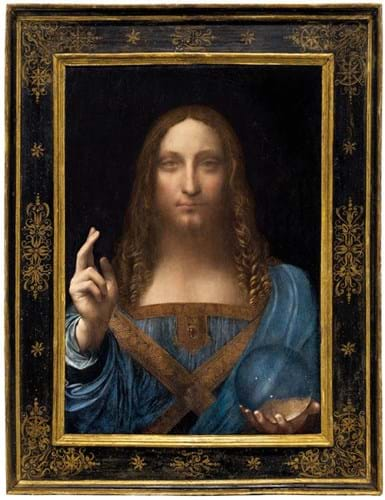
With an estimate in the region of $100m, the auctioneers have secured a third-party guarantee for the picture.
Unusually, it will be offered as ‘a special lot’ in Christie’s Post-War and Contemporary sale on November 15. Even the opening bid will easily surpass the £45m bid for Rubens’ The Massacre of the Innocents, sold at Sotheby’s London in 2002.
Salvator Mundi – acquired for under $10,000 by a small group of American dealers at a regional sale in 2005 – is understood to have been sold privately in an $80m deal brokered by Sotheby’s in 2013.
The buyer was Swiss ‘Freeports’ baron Yves Bouvier who then ‘flipped’ it to Russian billionaire Dmitry Rybolovlev for a sum reported to be over $120m. A detailed timeline of the picture’s colourful history – from its commission c.1500 for Louis XII to its unveiling as a new discovery in 2011 – appears below.
The work may not be fresh to the market or in ideal condition but, as Christie’s was keen to point out, Salvator Mundi is the only known painting by Leonardo in private hands. Collectors and institutions are unlikely to get another opportunity like this again.
Condition
The work, a 2ft 2in x 18in (66 x 45cm) oil on walnut panel, depicts Jesus as the ‘saviour of the world’. Christie’s told ATG it was too early to issue the full condition report, but did confirm a few details.
“Salvator Mundi is a 500-year-old painting and like most of that age, it has endured some wear and tear over the centuries. Significant areas remain in fine condition and many of the most important elements of the picture – the blessing hand, the orb, Christ’s vestments, the curls in his hair – are remarkably intact.”
ATG Comment
It is highly unusual for an Old Master painting to appear at an auction alongside works by the likes of Andy Warhol. Christie’s decision to offer Salvator Mundi at a contemporary art evening sale is clearly an attempt to pitch the work at collectors beyond the traditional hinterland and into areas where big-spending buyers may be less condition-conscious.
The fact that Christie’s has dropped Old Master sales in January and now stage them as part of its ‘Classic Week’ in April may also have been a factor in the decision.
Salvator Mundi – Timeline
16th century
Salvator Mundi was believed to have been painted by Leonardo for Louis XII of France in c.1500.
17th Century
The painting was first recorded in the Royal collection of King Charles I in 1649, the year of his execution, and thought to have hung in the private chambers of his wife Henrietta Maria in her palace in Greenwich. It was later in the collection of Charles II.
18th Century
Salvator Mundi was next recorded in a 1763 sale by Charles Herbert Sheffield, the illegitimate son of the Duke of Buckingham, who put it into auction following the sale of what is now Buckingham Palace to the king.
1900
Salvator Mundi’s whereabouts was unknown until 1900 when it was acquired by Sir Charles Robinson as a work by Leonardo’s follower, Bernardino Luini, for the Cook Collection, Doughty House, Richmond. By this time, its authorship by Leonardo, origins and illustrious royal history had been forgotten, and Christ’s face and hair were overpainted.
1958
In the dispersal of the Cook Collection, the painting was consigned to Sotheby’s in 1958 where it sold as a work by an unknown artist for £45.
2005
The painting then disappeared again until it was spotted in an estate sale at a small regional auction house in the US. The picture was acquired for under $10,000 by a small group of American dealers (including Alex Parish and Robert Simon).
2007
As the possibility of Leonardo's authorship emerged, the painting was shown to scholars in the autumn of 2007, including Mina Gregori of the University of Florence, Nicholas Penny, director of the National Gallery, and curators at the Metropolitan Museum in New York.
2008
In May 2008, it was taken to London to be directly compared with Leonardo's Virgin of the Rocks in the National Gallery.
2011
Salvator Mundi was unveiled as a new discovery of a work by Leonardo, the first since the Benois Madonna, now in the Hermitage in St. Petersburg, came to light in 1909. It was exhibited in public as part of the exhibition Leonardo da Vinci: Painter at the Court of Milan at The National Gallery in London.
2013
The picture is understood to have been sold privately in an $80m deal brokered by Sotheby’s in 2013. The buyer was Swiss ‘Freeports’ baron Yves Bouvier who then ‘flipped’ it to Russian billionaire Dmitry Rybolovlev for a sum reported to be over $120m.
2015
Bouvier and Rybolovlev became involved in an intense legal battle which has lasted over the last two years with Rybolovlev alleging he had been overcharged on a series of purchases made through Bouvier.
2017
Early in 2017, Christie’s sold a number of modern works from Rybolovlev’s collection including the Paul Gauguin landscape Te Fare (La Maison) that fetched £20.3m including premium. He is believed to have paid double this figure when he acquired it in June 2008.
The consignment of Salvator Mundi to Christie’s was announced last week and it will be offered in November with an estimate ‘in the region of $100m. The auctioneers will now tour the painting to key locations around the world including Hong Kong, San Francisco and London.














